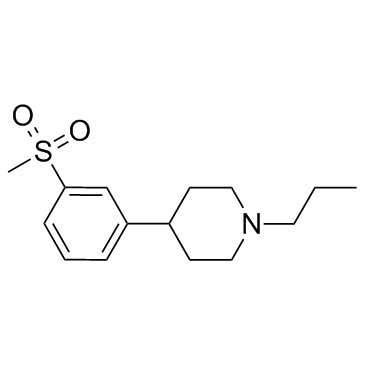346688-38-8
| Name | 4-(3-methylsulfonylphenyl)-1-propylpiperidine |
|---|---|
| Synonyms |
UNII-HD4TW8S2VK
ACR16 PRIDOPIDINE 4-[3-(Methylsulfonyl)phenyl]-1-propylpiperidine ACR16 compound |
| Description | Pridopidine, a dopamine (DA) stabilizer, acts as a low affinity dopamine D2 receptor (D2R) antagonist. Pridopidine exerts high affinity towards sigma 1 receptor (S1R) with Ki between 70 and 80 nM, which is ~100× higher than its affinity toward D2R. |
|---|---|
| Related Catalog | |
| Target |
Ki: 70-80 nM (sigma 1 receptor)[1] Dopamine[1] Dopamine D2 receptor[1] |
| In Vitro | Pridopidine, a dopamine (DA) stabilizer, Pridopidine may be a neuromodulatory agent with neuroprotective properties in Huntington disease (HD). To clarify the neuroprotective efficacy of Pridopidine and to explore the potential underling molecular mechanism, the ability of Pridopidine is evaluated to protect cells from apoptosis and to eventually activate pro-survival targets. Administration of Pridopidine (150 μM), the most effective dose, significantly reduces apoptosis in immortalized striatal knock-in cells expressing endogenous levels of mutant Htt (STHdh111/111) and markedly enhances phosphorylation state of prosurvival kinase ERK[2]. |
| In Vivo | Pridopidine is known to act as a low affinity D2R antagonist. Pridopidine’s activity may be attributed to binding the sigma 1 receptor (S1R), an endoplasmic reticulum (ER). To strengthen the hypothesis that the BDNF pathway is upregulated due to activation of the S1R, SD rats are treated with lower doses of Pridopidine (range 0.3-60 mg/kg), and analysed the expression of seven selected genes in the BDNF pathway by qPCR. Pridopidine doses of 3 and 15 mg/kg in rats occupy 57±2% and 85±2% of S1R, respectively, and both do not show occupancy of the D2R, as determined by in vivo PET imaging. The significant occupancy proportion of the D2R (44-66%) is observed only at a dose of 60 mg/kg. This PET study supports the conclusion that the upregulation of genes in rats treated with 15 mg/kg Pridopidine are a result of specific activation of the S1R. At 30 mg/kg, partial/low occupancy of the D2R is at levels of 22-33% (assuming linearity), and S1R is saturated. Indeed, qPCR analysis reveals that the upregulation of EGR1 (already up at 3 mg/kg), EGR2, HOMER1A, KLF5, and ARC expression are upregulated at the low 15 mg/kg dose and expression of CDNK1A and CEBPB are significantly upregulated from a low dose of 30 mg/kg (CEBPB is significantly increased at 3 mg/kg but not at 15 mg/kg)[1]. To further confirm the beneficial effect of Pridopidine on HD motor phenotype and to elucidate whether Pridopidine may act also as neuroprotective agent, preclinical studies in R6/2 mice have been undertaken. Daily administration of Pridopidine at a dose of 5 mg/kg, the most effective dose with no adverse effects, starting at the pre-symptomatic stage at 5 weeks for 6 weeks, significantly preserves motor function and prevents the progressive and dramatic motor worsening commonly observed in R6/2 mice. The beneficial effects of Pridopidine are maintained for about 4 weeks, after which mice show a slight worsening in performing both the horizontal ladder task and the open field. In addition, according to a Kaplan-Meier survival curve analysis, Pridopidine efficiently extends lifespan in the same mice[2]. |
| Cell Assay | Conditionally immortalized mouse striatal knock-in cells expressing endogenous levels of wild-type (STHdh7/7) or mHtt (STHdh111/111) are used. Different concentrations of Pridopidine (100, 150, 200 and 300 μM) are tested to investigate the anti-apoptotic effect of the molecule on immortalized cells cultured in serum-free medium at 39°C for six hours. In NE100 experiments, cells are pre-incubated with the compound (10 μM) for 2 hrs before culturing them in apoptotic conditions. At the end of each treatment, cells are collected and incubated with FITC-conjugated Annexin V. Fluorescence Activated Cell Sorting (FACS) analysis is performed[2]. |
| Animal Admin | Rats[1] Sprague Dawley (SD) male rats (n=6 per group) are treated daily by oral gavage with Pridopidine at a dose of 60 mg/kg or vehicle (water) over the course of 10 days. On day 10, 90 min following last drug/water administration, brains are removed, and quickly rinsed with cold physiological saline. The striatum of the left hemisphere is gently extracted and immediately immerged in 1000 µL of RNAlater Solution in pre-labelled polypropylene vials and stored at 4°C overnight (to allow the solution to thoroughly penetrate the tissue), then moved to -20°C until analysis. RNA is isolated from the striatum of each rat and analysed[1]. Mice[2] All in vivo experiments are conducted in R6/2 transgenic mice expressing exon 1 of human Htt with approximately 160±10 (CAG) repeats and manifesting first symptoms around week 7, and in wild-type (WT) littermates maintained on the B6CBA strain. Animals are housed singly and maintained under a 12-hr light/dark cycle environment in a clean facility and given free access to food pellets and water. Pridopidine is dissolved in saline (vehicle), and administered daily by intraperitoneal (i.p.) injection at a dose of 5 or 6 mg/kg per bodyweight during the light phase of the circadian rhythm. Control mice (WT and R6/2) are injected daily with the same volume of vehicle. All the mice are singly housed in home cage. Pridopidine (5 mg/kg) is administered to pre-symptomatic mice starting at week 5 to week 11 (6 week duration) and for symptomatic animals starting from week 7 to week 9 (3 weeks duration) and 1 week of daily administration (6 mg/kg) at week 10[2]. |
| References |
| Density | 1.093g/cm3 |
|---|---|
| Boiling Point | 434.205ºC at 760 mmHg |
| Melting Point | 73-75ºC |
| Molecular Formula | C15H23NO2S |
| Molecular Weight | 281.41400 |
| Flash Point | 216.4ºC |
| Exact Mass | 281.14500 |
| PSA | 45.76000 |
| LogP | 3.69820 |
| Index of Refraction | 1.526 |
| Storage condition | 2-8℃ |
| HS Code | 2933399090 |
|---|
| HS Code | 2933399090 |
|---|---|
| Summary | 2933399090. other compounds containing an unfused pyridine ring (whether or not hydrogenated) in the structure. VAT:17.0%. Tax rebate rate:13.0%. . MFN tariff:6.5%. General tariff:20.0% |


